Planting for Biodiversity
Encouraging and protecting our precious wildlife
Biodiversity is the range of animal and plant life in a habitat, and it’s incredibly important to both humans and the planet. Creating and promoting a biodiverse environment will help to preserve our planet for future generations, and will also enhance its beauty. Every green space, whether large or small, has the potential to be transformed into a haven for wildlife, and provides many benefits to biodiversity.
Unfortunately, the species population is currently in decline, due to various threats. Introducing a rich variety of plant species is a highly effective way of promoting wildlife, such as birds, mammals, and insects, to a green space. Different species can be attracted to a range of colours, shapes, and fragrances, as well as plants which flower and fruit during different seasons of the year. You can also incorporate a variation of native, near-native, and exotic plants to further enhance the biodiversity benefits.
Native plants have co-evolved with native wildlife, and give support to these local ecological systems. Due to naturally occurring within the region, native plants are better suited to establish and thrive within the area’s soil, climate, and light conditions, and they are more resilient to local pests—reducing the need for plant feed and pest control. In addition, native plants help to promote symbiotic relationships; these are mutually beneficial relationships between animals and plants. Read more about symbiotic relationships by checking out our blog.
How to encourage pollinators to your landscape
It’s highly beneficial to encourage a range of pollinators to your landscape, as pollination maintains biodiversity; it promotes the growth of plants and crops, leading to a balanced ecosystem. A wide range of other creatures benefit from food and habitat, which pollinators help to create. Without our valued pollinators, many other species would be at risk.
Pollen and nectar from flowers provide food for a wide variety of pollinators, such as butterflies, bees, beetles, and wasps. Plants which flower and fruit throughout various seasons are ideal for attracting different species all year round. Many butterflies and other pollinating insects source their food by scent, so these species can be attracted by incorporating plants with fragrant flowers.
Did you know?:
There are an abundance of pollinators which keep busy during the night, including moths, bats and beetles. These nocturnal pollinators are essential to our ecosystems.

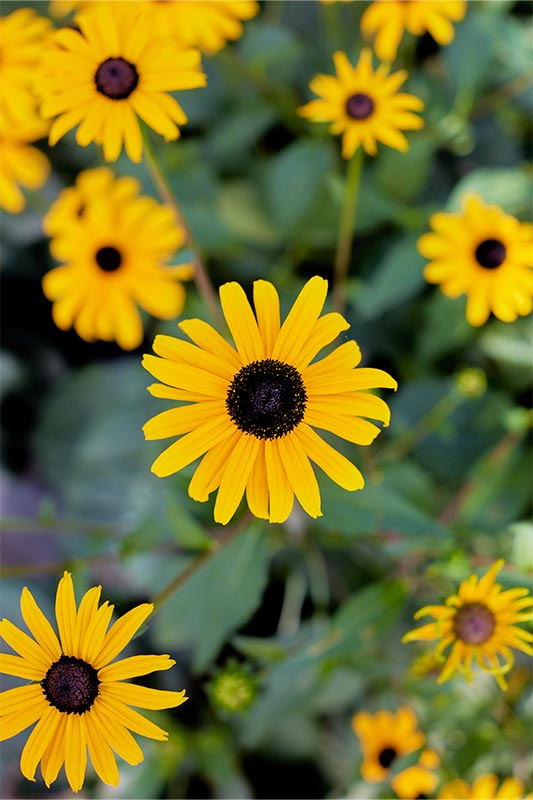
Rudbeckia fulgida var. sullivantii ‘Goldsturm’
Butterflies are a vital pollinator which bring movement and colour to landscapes. As well as being attracted to scent, they are allured by bright flowers, which they require to feed on their nectar and collect pollen, in order to carry and pass onto other plants; this action encourages seed production. Including plants such as Rudbeckia fulgida var. sullivantii ‘Goldsturm’ and Verbena bonariensis within your landscape will help to attract a wide range of butterflies. Rudbeckia fulgida var. sullivantii ‘Goldsturm’ is a perennial that boasts large, long-lasting, daisy-like, yellow flowers with black-brown centres from summer to autumn. It’s particularly striking when planted in drifts and works well combined with ornamental grasses. Rudbeckia fulgida var. sullivantii ‘Goldsturm’ is also useful for adding a splash of colour to borders. A true butterfly magnet, Verbena bonariensis is a perennial with tall branching stems and flattened heads of lilac-purple, late summer flowers. This plant works well as part of a prairie style planting theme and copes well in full sun.
You can benefit pollinators by providing pollen and nectar-rich flowers at various times throughout the year, and to help attract pollinators to your green space, we have collated a list of our planting recommendations, season by season. Spring flowering plants for pollinators include Helleborus foetidus, Rosmarinus officinalis, and Ajuga reptans. Native to the UK, Helleborus foetidus is a compact perennial with bell-shaped, lime green flowers from January to April, alongside dark green, deeply divided foliage. Rosmarinus officinalis is an upright evergreen shrub with aromatic, narrow green leaves that have white undersides. Widely used for culinary purposes, Rosmarinus officinalis boasts pretty light blue to white flowers from spring, but often repeats throughout the year—greatly appreciated by pollinators. Ajuga reptans is another UK native perennial that forms a wide mat of dark green carpet and bears erect spikes of deep blue flowers. It’s ideal for groundcover in shaded positions.
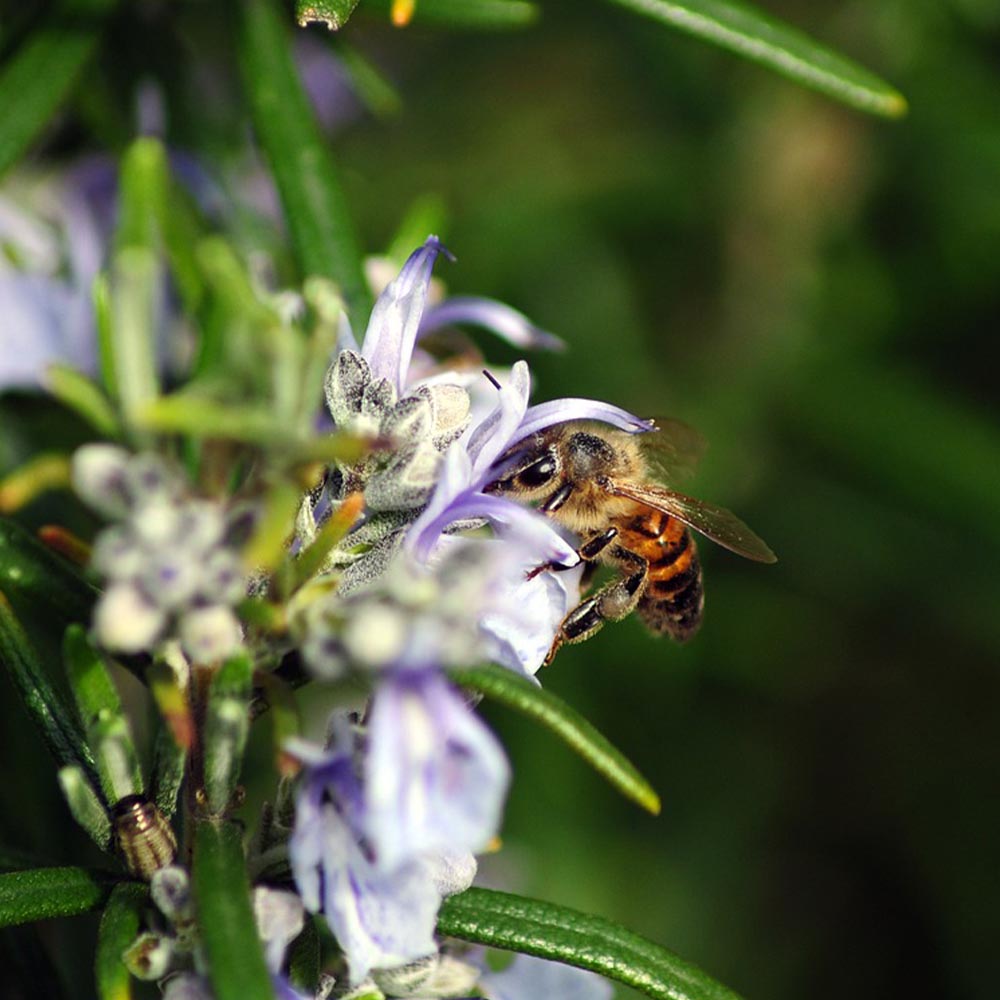
Bee on Rosmarinus officinalis
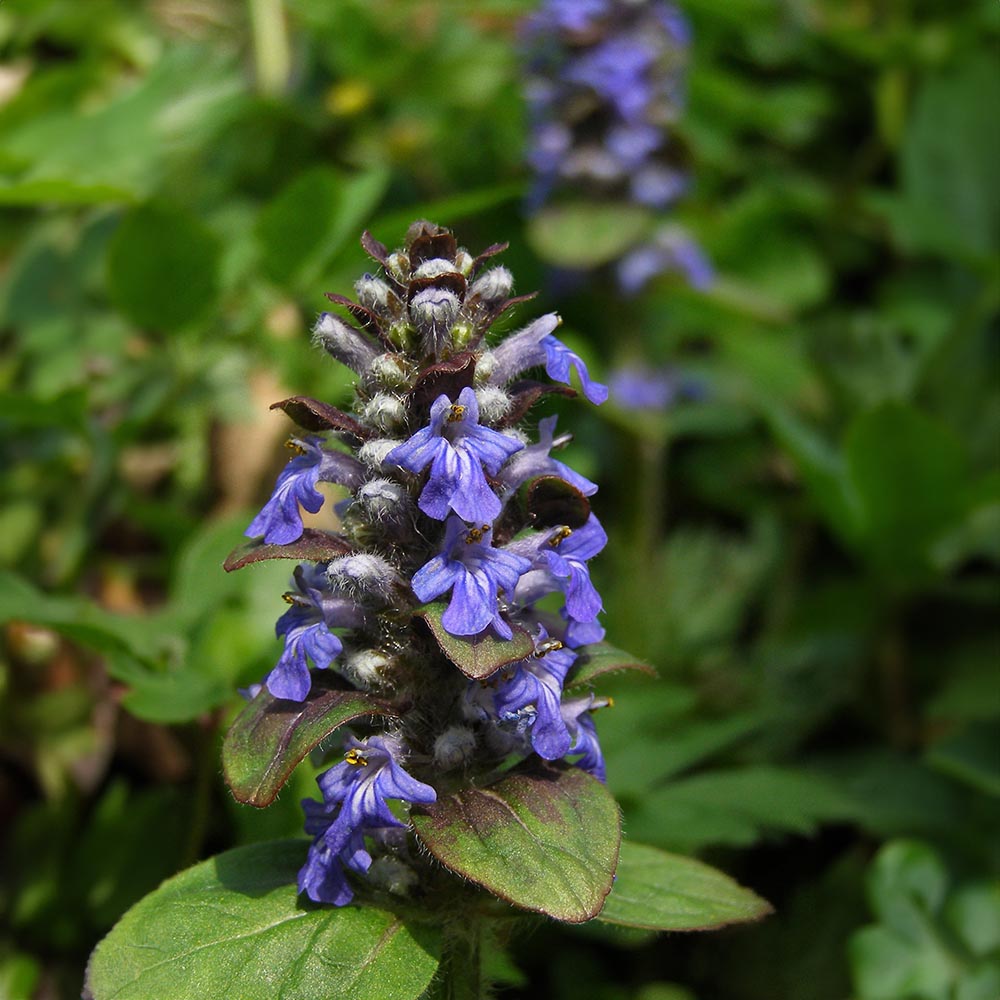
Ajuga reptans
For summer flowering, we recommend including plants such as Digitalis purpurea and Lonicera periclymenum. Digitalis purpurea is a deciduous biennial, with slightly hairy, oval-shaped foliage. It boasts magenta, tubular flowers in summer, which are adored by bees—especially long-tongued species. Digitalis purpurea is well suited to woodland edges or cottage gardens, and can handle coastal locations. Lonicera periclymenum is a vigorous, shrubby climber with green, oval-shaped foliage; white, purple flushed, highly scented flowers in summer; followed by glossy, red autumn berries.
As we move into autumn, plants including Sedum ‘Autumn Joy’, Salvia nemorosa ‘Caradonna’, and Hedera helix are ideal for attracting pollinators to your landscape. Also known as Hylotelephium ‘Herbstfreude’, Sedum ‘Autumn Joy’ is an upright perennial with succulent-like, grey-green foliage and flat-topped, salmon pink flowerheads which appear from late summer. These stunning flowerheads transition to pink-bronze, and eventually copper-red, boasting fantastic autumn colour. First blooming in June, Salvia nemorosa ‘Caradonna’ is a mound-forming perennial with rough, grey-green leaves and blue-black stems bearing upright racemes of violet-blue until around October. Lastly, Hedera helix is a useful addition for pollinators from September to October. Hedera helix is a fast growing, self-clinging, native ivy with glossy, diamond-shaped, lobed foliage once it matures, alongside green-yellow flowers, followed by black berries during winter.
Planting for pollinators in winter can be tricky, but there are plenty of plant species which offer nectar and pollen during the colder months of the year. We recommend including Viburnum x bodnantense ‘Dawn’ and Mahonia x media ‘Charity’. Viburnum x bodnantense ‘Dawn’ is a tall, deciduous shrub with ovate, dark green foliage and clusters of fragrant, pink flowers which appear on bare branches from November. These winter flowers are highly appreciated by bees and other pollinators, and are lovely for planting near entrances or walkways to appreciate the scent. Blooming from November to March, Mahonia x media ‘Charity’ is highly valuable to pollinators. This evergreen shrub has spikes of pale yellow flowers above rosettes of spiky, dark green leaves. It provides a lovely fragrance through the winter months and nectar for pollinating insects, as well as berries which birds love.
Head to our “Plants to Attract Bees” blog for more year-round planting recommendations for attracting bees and other pollinators.

Bee flying around Digitalis purpurea
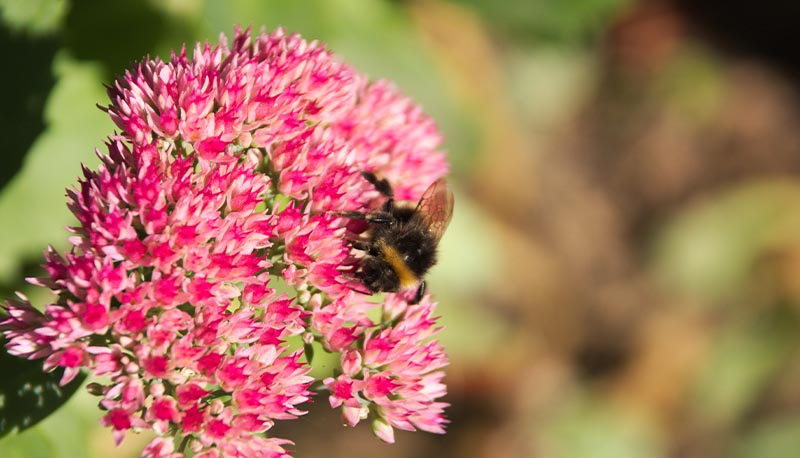
Bee on Sedum ‘Autumn Joy’

Bee on Mahonia x media ‘Charity’
How to encourage birds to your landscape
Birds are an important part of our ecosystem, and a decline in their natural habitats makes bird friendly landscapes more vital than ever. They require natural food, including berries and seeds, which can be provided through trees, shrubs, and lawns. Encouraging birds to your landscape brings great health and aesthetic benefits, as many help to control various pests and also feed on weeds. Birds have an excellent ability of spreading seeds; this process, known as “seed dispersal”, is beneficial for landscapes as plants are spread across great distances. In addition to food, birds require shelter, especially during cold weather and throughout the night. Many trees and shrubs are useful for this and can easily be incorporated within your landscape. Water is another important feature to consider, for drinking and bathing purposes. Water can be facilitated by including bird baths, ponds, or water features with running water; these will also attract a plethora of other wildlife, including amphibians and insects.
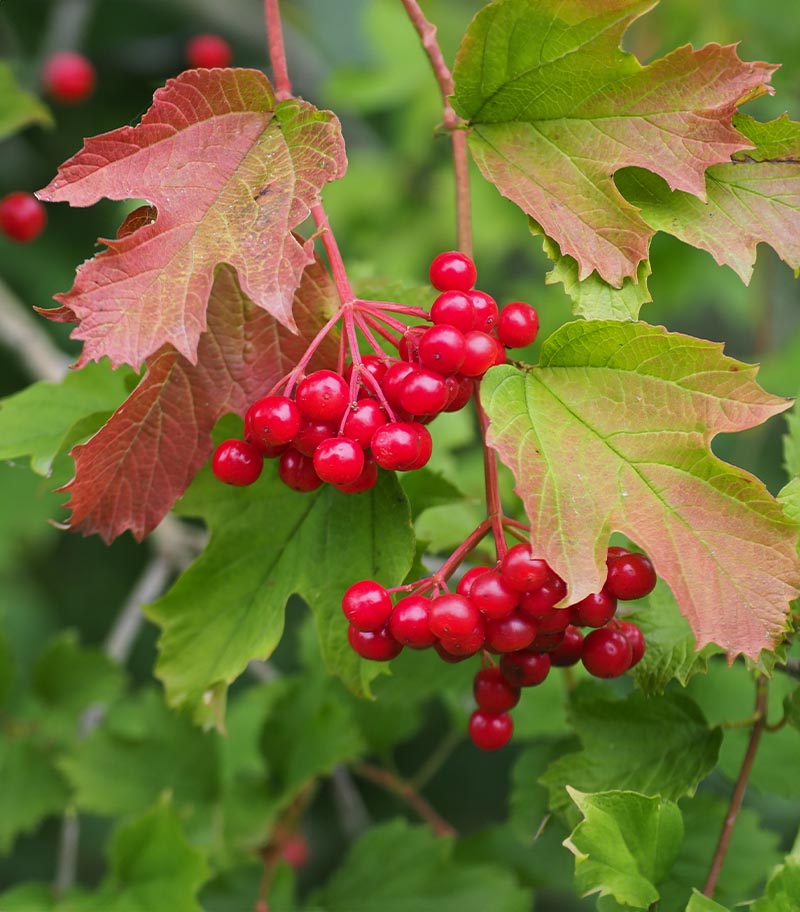
Viburnum opulus berries
With birds mainly requiring both shelter and food, it’s necessary to include plants within your landscape which provide these key elements. For food, plants such as Echinacea purpurea, Symphoricarpos × chenaultii ‘Hancock’, and Viburnum opulus are highly valuable for birds. Echinacea purpurea is a useful perennial for seeds—especially if it’s left during the winter. It’s an upright herbaceous perennial with ovate, hairy foliage and large, striking, solitary pink flowers that feature a central, orange-brown disk; a wonderful addition to a cottage style garden. Symphoricarpos × chenaultii ‘Hancock’ is a low growing, deciduous shrub with rooting branches, small leaves, and tiny white flowers which are followed by clusters of white berries with red speckles, lasting into winter. Its flowers are adored by bees and butterflies, whilst birds enjoy its berries. Viburnum opulus is a vigorous native shrub with lobed, maple-like leaves that provide lovely autumn colour. Snowball-like clusters of white, or green tinted flowers bloom in spring, and are followed by translucent red berries, which birds use as a food source throughout autumn.
For the best chances of encouraging birds to your landscape, it’s essential to include trees within your planting scheme. Providing fundamental habitats, trees are useful for nesting, as well as a source of materials for nest-building. Trees provide birds with an important food source, including seeds, berries, and nectar, and their leaves can collect water for birds to drink from.
Malus is excellent as a food source for birds; some of our favourite varieties include Malus ‘John Downie’, Malus ‘Red Sentinel’, and Malus ‘Evereste’. Malus ‘John Downie’ is a small crab apple with an upright habit that grows up to 6m. Its glossy green foliage emerge in spring, with pink buds which open to masses of white flowers. It produces red blushed, orange fruits in autumn. Providing beautiful autumnal colour, Malus ‘Red Sentinel’ is an upright deciduous tree, growing up to 8m, with highly scented white blossom and clusters of glossy, red fruits that last through to winter. Loved by thrushes and blackbirds, Malus ‘Evereste’ is a small deciduous tree with a conical shape that grows up to 7m. It offers multiple seasons of interest with its red buds which open to fragrant, white, spring blossoms; followed by red flushed, orange-yellow crab apples which are loved by birds; and lobed foliage which emerges green in spring and transitions to warm shades of yellow and orange in autumn.
In addition to Malus varieties, we also recommend Amelanchier arborea ‘Robin Hill’ and Ilex aquifolium for attracting birds to your landscape. Amelanchier arborea ‘Robin Hill’ is a small upright tree that grows up to 8m in height, with foliage which emerges bronze and gradually changes to green during summer. In autumn, it then transitions further to warm shades of orange and red. A favourite amongst many bird species, Ilex aquifolium is a slow growing, evergreen species with spiny, green foliage and a bushy habit. White flowers usually emerge in late spring or summer, and pollinated, female plants produce striking red berries during autumn and winter. Growing up to 10m in height, Ilex aquifolium works well as a specimen tree, and can also be grown as a clipped bush or for hedging. This species is very popular with birds, as its spiny, dense foliage offer excellent shelter, whilst its berries provide food.
For more tree recommendations, take a look at our “Trees to attract birds” blog.
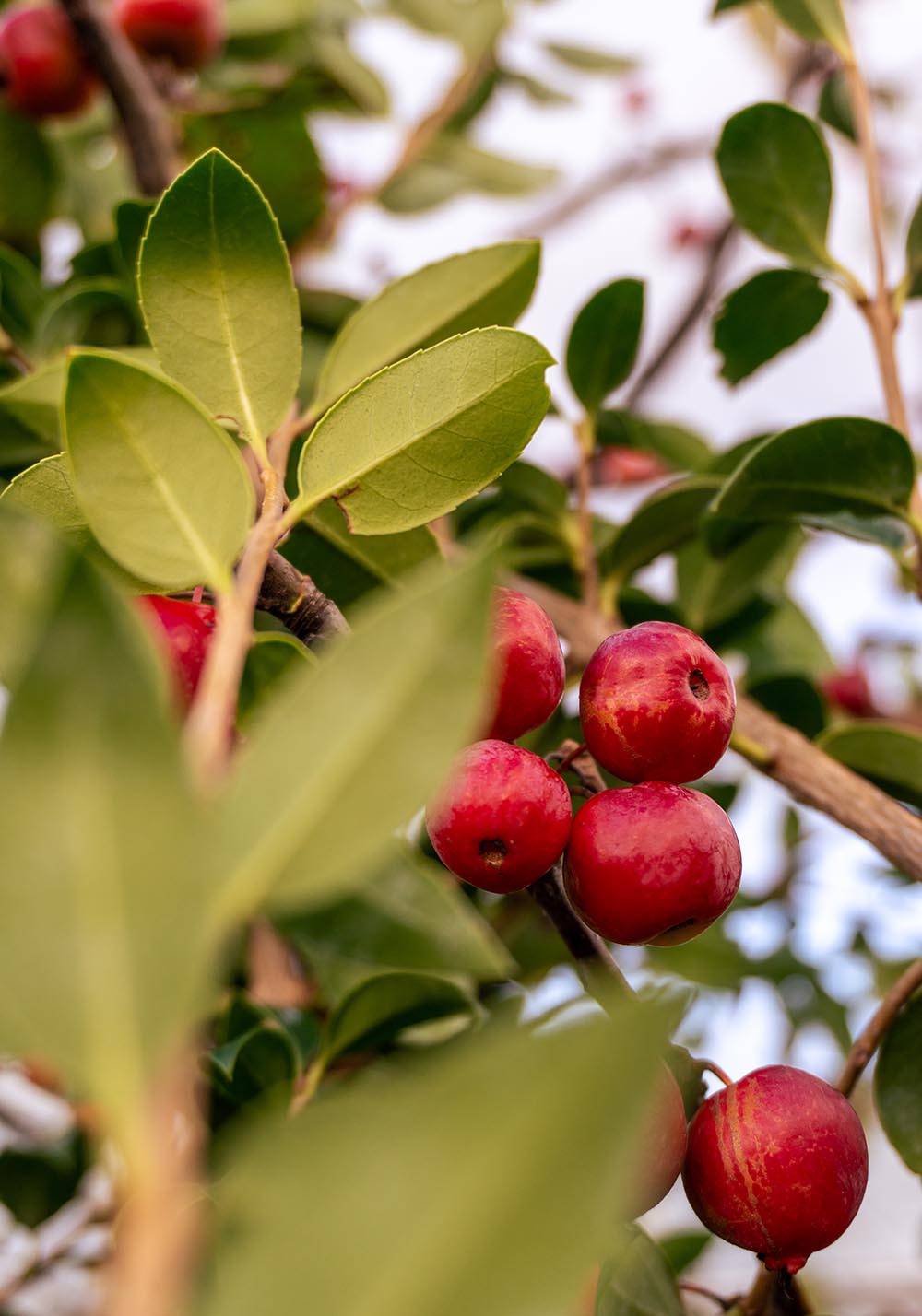
Malus ‘Evereste’
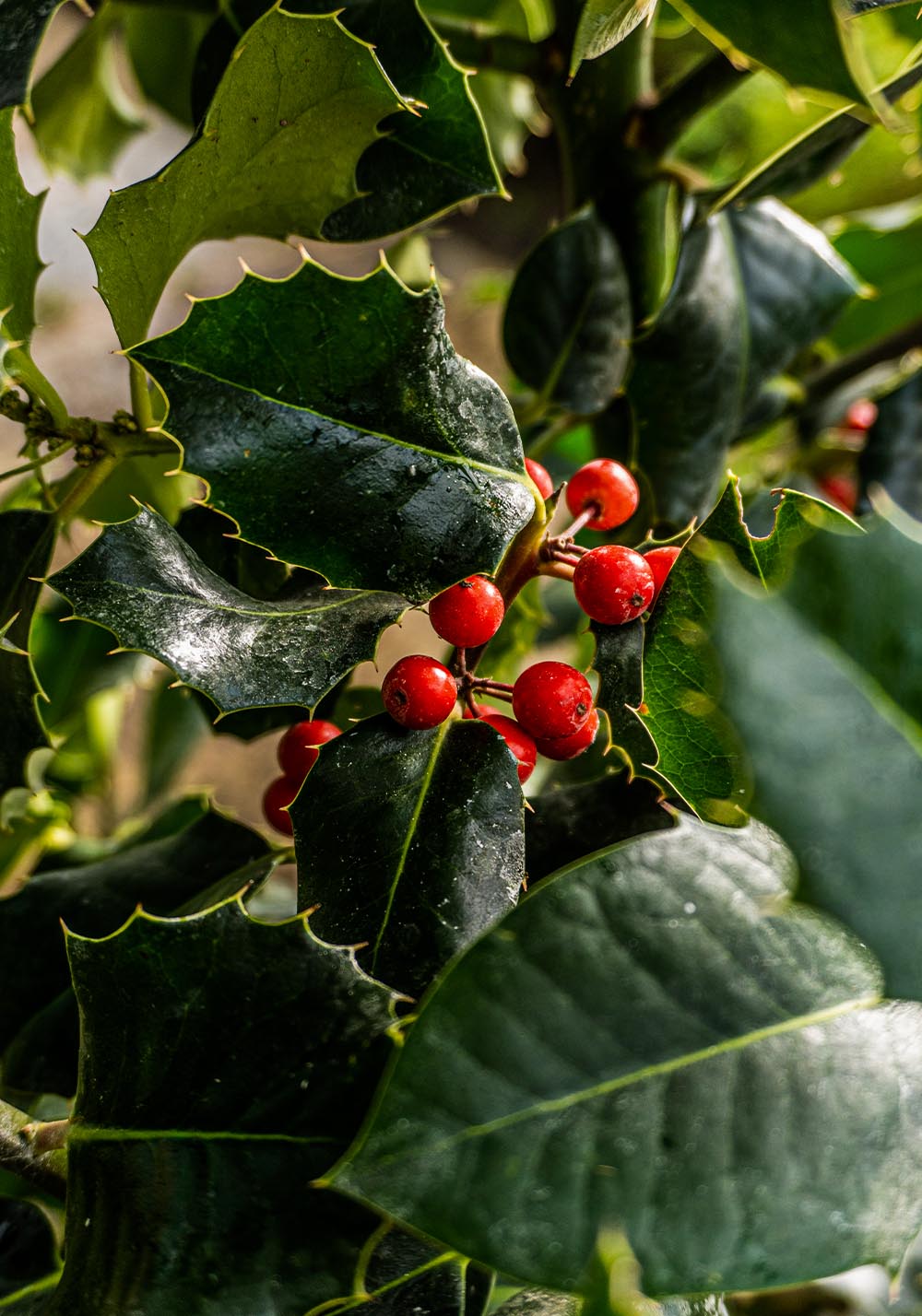
Ilex aquifolium
Biological Pest Control
Promoting biodiversity within your green space doesn’t solely rely on the plants you choose; it also involves the products used to control pest populations. Unfortunately, chemicals such as pesticides, insecticides, and fungicides can have a harmful impact on biodiversity, including the decline in populations of birds, insects, and bats.
Biological pest control methods are an environmentally friendly alternative to chemicals; it’s the use of living organisms to suppress or eradicate pest populations. Biological methods are either low or non-toxic, and have the ability to degrade quickly, without leaving any residues behind.
At Greenwood Plants, we are continually increasing our usage of biological control methods, and reducing the chemical methods we use across our nurseries. We are in the process of trialling different methods to control pest populations in an environmentally friendly way, and our goal is to reduce our pesticide use by 50%.
Head to our “Biological Pest Control” blog for more information on the products we are trialling throughout our nurseries.
Biodiversity Net Gain
Biodiversity Net Gain is an increasingly important topic. Contributions to the recovery of the natural environment, when developing land, and improvements to the local wildlife habitat will be mandatory from November 2023, under the Town and Country Planning Act 1990. Developers, land managers, and local planning authorities must have a plan to avoid the loss of habitat on-site or compensate by investing in habitat creation elsewhere.
Get in touch with our expert G Team if you need advice on planting to improve biodiversity, or head to our innovative Tender Tool app to get a quick and easy quote.

